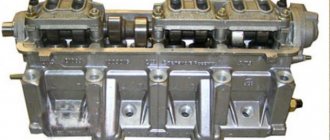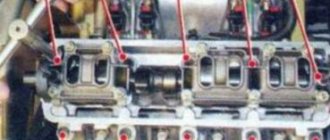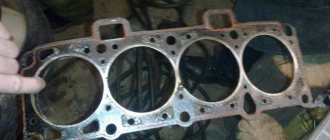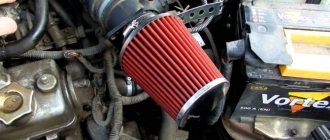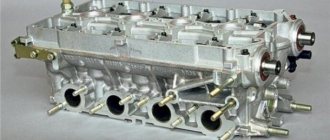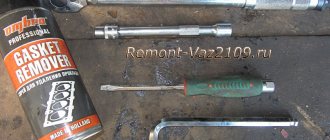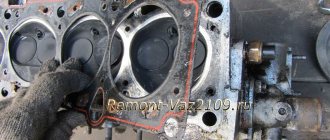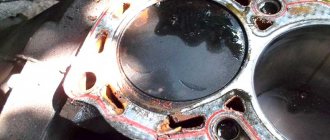The head gasket is installed between the cylinder block (BC) and the cylinder head (cylinder head) of the car engine. The part serves to seal the combustion chambers, preventing gas leakage, as well as to seal the channels between the BC and the cylinder head in order to prevent the leakage of engine oil and coolant.
Failure of the cylinder head gasket of a VAZ 2114 (breakdown, burnout) will lead to problems and malfunctions in the operation of the vehicle’s internal combustion engine: engine overheating, the appearance of an emulsion in the engine oil, etc. To eliminate the malfunction, the gasket is changed. Next, we will look at what a cylinder head gasket 2114 is, when you need to change the head gasket and how the replacement is performed.
VAZ-2114 engine structure diagram
Cylinder head gasket close up (engine removed)
In order to understand the process and principle of replacing engine gaskets, you need to know the structure and sequence of parts in the main power unit.
So, let's look at the design of the VAZ-2114 engine:
Engine diagram and structure
No. Part number Name of spare part
| 1 | 2108-1003298 | screw |
| 2 | 2108-1003278-01 | Washer |
| 3 | 2108-1003277-01 | Sleeve |
| 3 | 2108-1003277-02 | Sleeve |
| 4 | 2108-1003274 | Cover pin |
| 5 | 2111-1003260 | Cylinder head cover |
| 6 | 2108-1003271 | Bolt M12x1.25x135 |
| 7 | 2108-1003265 | Washer |
| 8 | 14328201 | Plug 10 cup |
| 9 | 14329101 | Plug 30 cup |
| 10 | 1118-1003011 | Cylinder head |
| 11 | 2101-1002042 | Sleeve |
| 12 | 14329201 | Plug 36 cup |
| 13 | 10158601 | Plug 16 spherical |
| 14 | 11183-1002011-10 | Cylinder block |
| 15 | 14234330 | Bolt M10x1.25x65 |
| 16 | 2108-1003284-10 | Ring sealing |
| 17 | 2111-1003284 | Ring sealing |
| 18 | 2111-1003286 | Bolt |
| 19 | 2111-1003288-10 | Stub |
| 20 | 10725911 | Nut M6 low |
| 21 | 11197773 | Conical spring washer 6 |
| 22 | 13541221 | Hairpin M6x22 |
| 23 | 2108-1003270-10 | Cover gasket |
| 23 | 2108-1003270-11 | Cylinder head cover gasket |
| 24 | 21083-1003020-10 | Head gasket |
| 24 | 21083-1003020-11 | Head gasket |
| 25 | 2112-3855020 | Knock sensor |
| 25 | 2112-3855020-01 | Knock sensor |
| 25 | 2112-3855020-02 | Knock sensor |
| 25 | 2112-3855020-03 | Knock sensor |
| 26 | 2101-1002040 | Sleeve |
Where is the cylinder head gasket located on a VAZ 2114?
In a VAZ 2114 car, an injector with an engine of 8 or 16 valves, the seal is installed at the junction of the cylinder head with the block itself. Structurally, this element consists of several layers. High-quality sealing is ensured thanks to sheet steel, fiber, cardboard and other materials that are pressed together and covered with one layer of sealant.
Damaged cylinder head gasket VAZ 2114
Torque
After installing the part, tighten the bolts using a torque wrench. Tightening is done from the center. The bottom bolt goes first and then the top center bolt. The tightening is done in four steps. First, the bolts are tightened with a force of 2 kilograms per centimeter (for VAZ-2108-21099 cars). Then they tighten in the second circle with a force of 8 kgf*m (also from the center). After this, each bolt is tightened 90 degrees. Then they are tightened again, also 90 degrees.
Gasket selection
In addition to the original spare part, there is a set of analogues that can be installed on the VAZ-2114. Some of them are of high quality and have a service life much longer than the original. So, let's look at what gasket options exist for the 14th series of Lada cars.
Original
21083-1003020 – catalog number of the original head gasket. It fits perfectly into the seats and is recommended for installation by the manufacturer. It is produced at the AvtoVAZ plant and the retail price is 600 rubles.
Analogs
In addition to the original part, there are a sufficient number of analogues that are certified and, as practice shows, are installed on cars.
So, let's look at which cylinder head gaskets can be installed instead of the original: Manufacturer's name Catalog number Cost in rubles
| Master-sport | 463-915-PCS-MS | 300 |
| Reinz | 61-31045-00 | 400 |
| Patron | PG2-0151 | 450 |
| Elring | 463.915 | 500 |
| Glaser | H50120-00 | 900 |
| Ajusa | 10033100 | 1000 |
| Trialli | GZ 101 7022 | 1500 |
Cylinder head gasket made by Elring
Gasket requirements
When changing and choosing a cylinder head gasket, you must always look at the quality of the product. But not everyone knows what properties it should have. Let's consider the basic requirements for this spare part:
- Long service life.
- Elastic deformation.
- Resistant to hot gases.
- Water and oil resistant.
- Resistance to chemical reactions and influences.
If the selected head gasket meets all standards, then it can be installed on the car.
conclusions
Replacing the head gasket on a VAZ-2114 is quite difficult, since you need to know the design features of this engine, as well as have experience in performing such operations on similar engines.
The choice of gasket should be approached seriously and carefully, since the normal operation of many components depends on its condition. If the process described in the article seems quite complicated and the motorist is not able to carry out the operation on his own, then it is recommended to contact a car service center, where they will help and do everything quickly and efficiently.
Symptoms of a problem
So, when all the points have been considered, it remains to list the signs of cylinder head gasket failure:
- A large amount of white smoke comes out of the muffler.
White smoke from the muffler is a sign of a faulty cylinder head gasket
- Sufficient amount of emulsion on the filler cap.
Emulsion on the filler cap
- Antifreeze has an oil effect.
- The oil level in the pan has increased.
- The smell of antifreeze or exhaust gases can be traced in gasoline.
This is interesting: Spare parts for foreign cars
Results
In conclusion, we note once again that if you identify signs of a broken cylinder head gasket, you must immediately go to a service station for replacement or do the work yourself.
It is important not just to replace the damaged element, but to find the cause of the malfunction. For example, if it is an overheating of the engine, you must first deal with the problem, and only then install a new cylinder head gasket.
When replacing, follow the manufacturer’s recommendations in terms of the sequence of actions and tightening torque, because if these rules are violated, the product will not last long. But in such matters, the right thing to do is to find a good specialist and entrust all the work to him.
Found a mistake or disagree with something? Write in the comments.
When is it time to change the block head?
The cylinder head is a fairly strong unit and its replacement and repair is infrequent. On domestically produced cars, as a rule, it has to be removed due to cylinder leakage or gasket wear.
New gasket
Also removed for revision. Removing and replacing, on a car with any number of valves, the process itself is not difficult, but some skills and some experience are required. Therefore, if you are removing the cylinder head for the first time, it would be better to invite a more experienced car enthusiast as an assistant. One who has already dealt with this work, or better yet, if he has already completed modifications or repairs to this unit.
Sequence of repair work
Installing the cylinder head
Also need a new head gasket and valve cover gasket. Having all this, you can begin the renovation. The sequence of actions for repairs is as follows:
- The car is placed in the garage, the gearbox is set to neutral, and chocks are placed under the rear wheels. The first thing that is done after setting up the car is to de-energize the on-board network by disconnecting the “-” terminal from the battery.
- The pressure in the fuel system is relieved. For this purpose, there is a control valve on the fuel rail in the form of a regular tire valve. You need to place a container under this valve and clamp the spool. When the pressure is released, gasoline will leak out. You will also need to drain the coolant using drain plugs.
- On the engine, you need to set the piston of the 1st cylinder to the TDC position. To do this, remove the protective cover of the timing belt and rotate the crankshaft until the marks on the pulley, camshaft and flywheel match.
- The next step is to remove the valve covers. To do this, all pipes, the throttle drive rod, the accelerator drive bracket and the valve cover mounting nuts are disconnected from the cover fittings.
- The exhaust pipe of the exhaust gas removal system is disconnected from the exhaust manifold. These works are carried out under the car.
- The wiring is disconnected from the mass flow sensor, the air supply pipe to the throttle assembly is removed, after which it is completely dismantled along with the air filter housing.
- Then you need to disconnect from the head all the elements suitable for the head - pipes of the cooling system of the throttle assembly, vacuum booster, throttle drive linkage, ground wires, bracket for the exhaust manifold supply pipe.
- The intake manifold strut mounts are also loosened, and the struts themselves are removed. Next, the wiring is disconnected from - oil pressure sensors, coolant temperature and throttle position sensors, XX regulator, injectors, high-voltage wires from spark plugs.
- Then the timing belt is removed. Before this, you need to once again check the alignment of the marks on the crankshaft pulley and the timing gear. After this, the belt tension is loosened and it is removed from the timing gear.
- To remove the camshaft gear, you will need to fix it through the technological holes and unscrew the fastening bolt. You need to remove it from the shaft carefully so as not to lose the key. After this, you will need to remove the rear cover, located behind the removed gear, from the head and block.
- The cooling system pipes are removed from the head along with the thermostat from the head, as well as the rest of the wiring. The fuel supply and drain pipes are also disconnected.
- All that remains is to unscrew the head bolts. But to do this, they must first be weakened, and in a strictly defined order. And only after relaxation do they completely unscrew. If disassembly is done correctly, after removing the bolts, you can remove the head and remove the damaged gasket. At this point, the first part of the repair is considered complete.
How to properly replace a gasket with your own hands?
If you notice signs of a broken cylinder head gasket on a VAZ 2114, and after inspection you are convinced that this is indeed the case, then the only way to solve this problem is to replace the gasket.
Of course, this can be done at a car service center, but this generally simple operation will be quite expensive. That is why you can replace the gasket yourself.
The very first thing you need to do for this is to disconnect all devices and instruments connected to the engine, remove belts, etc. It wouldn’t hurt to write down everything that was filmed (so that later there won’t be anything “extra”).
Then you need to unscrew the head mounting bolts.
To do this, we first clean them of dirt, rust and technical fluids, and then unscrew them one by one (first, each of the bolts must be turned slightly, and only after doing this procedure with all the bolts, unscrew them completely).
After this, we dismantle the worn gasket and install a new one in its place (you need to focus on the bushings and protrusions - they will help install the gasket in the correct position, without unevenness and distortions).
When the new gasket is installed, all that remains is to reconnect all the units, and then secure the cylinder head with bolts.
Special attention should be paid to the fact that this should not be done “by eye” - this will lead to very rapid wear of the gasket, and it will have to be changed again. For this reason, the bolts are tightened only with the use of a torque wrench and only to the amount specified in the passport.
Required Tools
What you will need to complete the task:
- set of wrenches;
- socket wrenches;
- set of hex keys;
- two screwdrivers - with a Phillips and a flat tip;
- new seal for the cylinder head of the VAZ 2114;
- a bucket or cut-off bottle into which the used refrigerant will be drained;
- clean rags;
- torque wrench for tightening the cylinder head bolts.
The Jecos Presents channel published a video showing an overview of a damaged cylinder head gasket on a VAZ 2114.
Algorithm of actions
Instructions for replacing the gasket yourself:
- Drive the car into a garage with a pit. Work on the overpass is allowed.
- Turn off the voltage in the vehicle's on-board network. Open the hood, loosen the bolt on the negative terminal of the battery and disconnect it.
- The piston of cylinder 1 must be fixed in the top dead center position. To do this, set the gearbox selector in the passenger compartment to the neutral position. Place bricks or wheel chocks under the wheels. Unscrew the bolts securing the right wheel of the car and remove it. Unscrew the screws securing the engine compartment mudguard and remove the product. Then unscrew the screws securing the front camshaft drive belt cover, and then disconnect it. The engine crankshaft is rotated by the screw that secures the generator set pulley to it. The device is rotated until the marks on the camshaft pulley coincide with the marks on the rear cover. Remove the plug from the service hole on the clutch housing, make sure that the marks on the flywheel match.
- Open the coolant drain plug by placing a bucket or cut-off bottle underneath it. Wait until the refrigerant has completely drained from the system.
- Relieve pressure in the vehicle fuel lines.
- Loosen the clamp and disconnect the exhaust system intake line from the exhaust manifold.
- Dismantle the cylinder head cover; to do this, you need to disconnect the throttle, as well as the receiver and the intake and exhaust manifolds.
- Using a screwdriver, loosen the clamp that secures the air supply line to the throttle. Remove it from the assembly with the air flow intake pipe and the cleaning device housing.
- To the left of the cylinder head of your car you will see several ground wires, that is, ground. They must be disconnected and the fuel rail and other system components removed.
- Unscrew the bolts securing the front cover, and then remove the timing belt. The crankshaft must be secured against turning.
- Loosen the bolt securing the tension roller and remove it. Also remove the spacer washer. Unscrew the screw securing the camshaft toothed disk and remove it.
- Remove the back cover. To do this, unscrew the nut that secures it, and then unscrew the other screws that secure the device. Using a Phillips head screwdriver, unscrew the bolts and loosen the clamps, disconnecting all lines from the cylinder head exhaust hose one by one. We are talking about the inlet pipe of the radiator unit, thermostat lines and hoses of the throttle and heating system. Check their integrity and replace if necessary. After unscrewing the nuts, disconnect the fuel drain and fuel supply lines.
- Using a hex wrench, remove the ten retaining screws. When unscrewing, we recommend turning them alternately by half a turn, first the middle bolts, and then the side ones. This will reduce the pressure and prevent the possibility of cylinder head deformation. The bolts are removed from their seats with washers.
- Remove the cylinder head with the sealing gasket.
- Clean the surfaces of the head and block from remnants of the old gasket and dirt, as well as metal dust. Make sure there is no engine fluid in the threaded holes. Otherwise, it must be removed. Clean carefully so as not to damage the surfaces.
- Install a new gasket. When installing, take into account the position of the two centering sleeves. The installation must be done so that the hole with copper edging is located between cylinders 3 and 4. This hole is used for the passage of engine fluid through the lubrication system. Before installing the head, make sure that the valves on the first cylinder are closed.
- Install the cylinder head. During installation, the bolts are placed in the technological holes. All screws are tightened in accordance with the diagram below - first the central ones, then the side ones. As for tightening, first tighten the bolts with a torque wrench with a force of 20 Nm. After this, observing the tightening sequence, the bolts are tightened to 69.4 - 85.7 Nm. All elements must be tightened with the same force. Then the screws are tightened 90 degrees, and at the final stage the bolts are turned another 90 degrees.
- After installing the cylinder head, all previously disconnected components are installed in the reverse order. The disconnected pipes, as well as the wires with the controller plugs, are reconnected. At the final stage, perform diagnostics and adjust the clearances in the valve drive. Reinstall the timing belt. Make sure it is intact and well tensioned.
- Fill the cooling system with fresh antifreeze. Start the engine, warm it up and make sure there are no coolant leaks.
This is interesting: Replacing the standard radio in a Skoda Octavia car with your own hands
Necessary tool
Engine repairs involving gasket replacement, although labor-intensive, can be done independently if you have the necessary equipment at hand.
Everything you need to perform the operation is listed below:
- sets of open-end and socket wrenches (you will especially need keys for “10”, “13”, “17” and “19”);
- a set of heads of the same dimensions, as well as a special “Torh” head;
- torque wrench;
- screwdrivers;
- pliers;
- containers for draining technical fluids;
- rags;
- sealant;
Consequences of untimely replacement
If the replacement is not done on time, it will lead to serious problems. Due to a broken gasket, engine oil will begin to enter the cooling system, which will disrupt its overall operation. Antifreeze will not be able to properly cool the power unit. The stove will work poorly, the engine power will decrease, and problems will arise in its operation. The engine will stall, in some cases it will be impossible to start it, and dips may be felt when you press the gas pedal.
Due to antifreeze entering the lubrication system, the oil will lose its properties. Lubrication of rubbing components and parts will be less effective, which will lead to their accelerated wear and damage. The engine will run rough and may overheat due to the loss of antifreeze properties. In the winter season, difficulties will arise with starting the engine. If you do not change the gasket and continue to use the car this way, this may lead to breakdown of the power unit and the need for major repairs.
Assembly Features
Before assembly, you should check the bolts securing the head to the hood; their length should not be more than 13.5 cm; if they are longer, they can no longer be used.
You should also check the flatness of the head. If it was overheated, it is possible that it was warped and will require repair in the form of trimming the plane.
During assembly, the head bolts are tightened in a certain sequence and with a strictly defined tightening torque. Next, everything is assembled in the reverse order of disassembly.
Disassembly is also carried out in the same sequence if the power plant is being modified.
